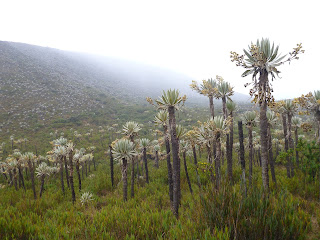 Before going to Chingaza, someone described visiting it as being like walking on the surface of the moon. If there had been a wet misty storm on the moon, perhaps I could have imagined it as such, but the vegetation was so unique that I could understand exactly what they were talking about. We climbed high above Bogota, up the Calera and into the Eastern Cordillera ranges behind it, through the pretty farmland plains until we were looking over the vast green Andean valleys, where the rain clouds were omnipresent and the coming mists could be seen from afar. As we left any cover of trees behind us and got progressively more wet, we marveled at the the low level of vegetation being able to hide deer, bears, tapirs, and pumas, though the ocelots, monkeys and turkeys seemed even more improbable. The one animal that is well suited to this environment, however, was the condor!
Before going to Chingaza, someone described visiting it as being like walking on the surface of the moon. If there had been a wet misty storm on the moon, perhaps I could have imagined it as such, but the vegetation was so unique that I could understand exactly what they were talking about. We climbed high above Bogota, up the Calera and into the Eastern Cordillera ranges behind it, through the pretty farmland plains until we were looking over the vast green Andean valleys, where the rain clouds were omnipresent and the coming mists could be seen from afar. As we left any cover of trees behind us and got progressively more wet, we marveled at the the low level of vegetation being able to hide deer, bears, tapirs, and pumas, though the ocelots, monkeys and turkeys seemed even more improbable. The one animal that is well suited to this environment, however, was the condor! The spiky alpine trees were a cross between cactuses and ferns, and emerged from the misty landscape as eerie shapes. The much cosier frailejones, furry leaved cactuses, seemed suited to the cold windy environment. Nearing 4200m above sea level, it was not an unusual thing for the park to be in the clouds while Bogota has a rare sunny day. The swamps and peat bog, and the constant mud were clear indications that this is not really a place to be traversed
We saw 3 of the approximately 40 glacial lakes that the park holds, which as a group are known as the Siecha Gaps, and found one or two of its swamps, too. It is a majestic area, with not a hint of civilization anywhere to be found other than the trails that people take in and out. We were thrilled to catch sight of the elusive dear soon after we set out.
Thankfully, the rain didn't continue forever -- a few clouds cleared themselves away, but the subsequent wind was almost as bad!
















0 comments:
Post a Comment